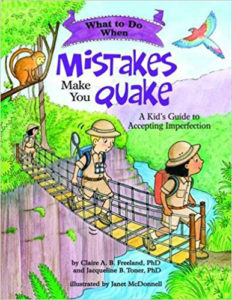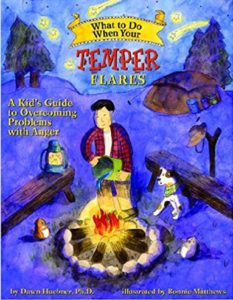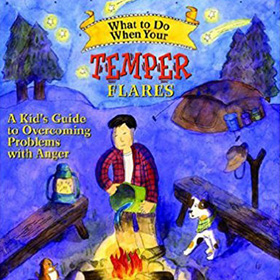by Lisa DeMarco and family •
Like most parents, my husband Bob and I are willing to go to great lengths to help our children grow up strong, healthy, and happy. We did this with our four biological children, and we are actively doing it with our two youngest children, who spent several years in foster care before joining our family through adoption. In fact, I am constantly seeking out books, resources, and support that will help our youngest children overcome issues related to their past. Here are two I’d particularly like to share with you.
Tackling Perfectionism
 What to Do When Mistakes Make You Quake: A Kid’s Guide to Accepting Imperfection (2015, Magination Press), by Claire Freeland, PhD and Jacqueline Toner, PhD, is an interactive workbook that guides children and their parents through the emotions underlying the fear of making mistakes using strategies and techniques based on cognitive-behavioral principles. It is recommended for children between the ages of six and 12. I worked through this book in a week with my daughter, who is almost 11 years old.
What to Do When Mistakes Make You Quake: A Kid’s Guide to Accepting Imperfection (2015, Magination Press), by Claire Freeland, PhD and Jacqueline Toner, PhD, is an interactive workbook that guides children and their parents through the emotions underlying the fear of making mistakes using strategies and techniques based on cognitive-behavioral principles. It is recommended for children between the ages of six and 12. I worked through this book in a week with my daughter, who is almost 11 years old.
When Mistakes Make You Quake has a colorful and inviting cover picture of three children exploring the outdoors, which makes the book look fun and interesting. There is a short introduction for parents and caregivers, which sets a good tone and makes it clear how to get started. The book has nine chapters and 96 pages. It is recommended to do only one or two chapters at a time. The pages are filled with activities for the child to work on and black-and-white drawings that can be colored.
There are multiple examples in the book of situations where a child might fear making mistakes, and then very practical strategies to help overcome those feelings. I loved the book because it allowed me to talk with my daughter about some of the things she’s dealing with in a way that wasn’t threatening. It also gave me useful ways to counteract her worries.
Here are some of my daughter’s comments when I asked what she thought of this book: “I liked to color the pictures. I liked the activities. I liked doing the activities with my mom, especially when she read it to me.” She also said that it was fun and enjoyable and didn’t feel like doing homework. At one point, I found her working on the book by herself. She even gave a few examples of activities in the book that she enjoyed: one was about locating beetles and one was about a teddy bear. On the last page is a certificate of completion, which she readily filled out and then photocopied so she could keep it with her.
I definitely would recommend this book to parents and children with similar struggles. It is a nice way to deal with a common issue that affects our children.
Managing Anger
 What to Do When Your Temper Flares: A Kid’s Guide to Overcoming Problems with Anger (2007, Magination Press), by Dawn Huebner, PhD is an interactive workbook for children ages six to 12. It guides children and their parents through cognitive-behavioral techniques used to treat problems with anger.
What to Do When Your Temper Flares: A Kid’s Guide to Overcoming Problems with Anger (2007, Magination Press), by Dawn Huebner, PhD is an interactive workbook for children ages six to 12. It guides children and their parents through cognitive-behavioral techniques used to treat problems with anger.
I worked through this book with my 12-year-old son, who generally doesn’t like to do anything that even vaguely resembles therapy.
The cover of the book has a wonderful picture of a boy and his dog camping, and the boy is dousing the campfire with a bucket of water. The picture itself makes you want to open the book. Its 12 chapters and 96 pages are filled with black-and-white pictures that can be colored. The print is large, so nothing looks too overwhelming. The activities are engaging and thought-provoking, but not too intense.
The introduction to parents and caregivers is short and helpful. It gives insight to parents on how to effectively help our children who struggle with managing anger. It is recommended to cover only one or two chapters at a time, which worked very well for my son. The book helps a parent (or caregiver) and a child can sit down together and in a non-judgmental way explore issues that lead to angry feelings.
This book offers real world techniques for managing anger. It makes the analogy of anger being like a fire, and then suggests several “anger-dousing” methods. It also addresses recognizing “sparks” which may lead to anger, as well as what to do when someone intentionally causes sparks to happen.
This book was equipping and encouraging. I especially liked working on it together with my son because it gave me tools to actually help him, instead of always getting frustrated with his angry outbursts.
He seemed to actually enjoy the book and even completed it without too much protest. (This, is very impressive in my home!) He liked drawing pictures and taking turns reading. We have been able to use examples and strategies from this book to help us in real life situations. We have found the “prickly ball” analogy particularly helpful. (You’ll have to get the book if you’re curious!)
This book was meatier than Mistakes that Make You Quake; I probably will go through it myself a second time, so I can continue to reinforce the things we learned together.
There are several other “What to Do” guides for kids. Based on my family’s experience, they may be worth looking into if they touch on issues relevant to your kids. Titles in this series include:
- What to do When You Grumble Too Much: A Kid’s Guide to Overcoming Negativity
- What to Do When Your Brain Gets Stuck: A Kid’s Guide to Overcoming OCD
- What to Do When You Dread Your Bed: A Kid’s Guide to Overcoming Problems with Sleep
- What to Do When Bad Habits Take Hold: A Kid’s Guide to Overcoming Nail Biting and More
- What to Do When You Worry Too Much: A Kid’s Guide to Overcoming Anxiety


